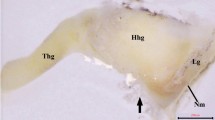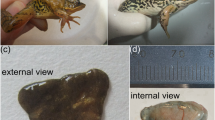Abstract
The preorbital gland is a specialized dermal gland of antelopes which plays an important role in territorial marking behavior and pheromonal communication. To our knowledge, there is little information available on the role of preorbital gland marks in Indian antelopes (blackbucks). Males are seen averting the gland during behavioural display and territorial marking but the functional aspect of this gland has not been examined. Hence, the aim of this study was to describe the histomorphology of the preorbital gland in territorial and non-territorial male blackbucks to determine its morphology and secretory function. The results showed that the preorbital gland is composed of modified sebaceous and apocrine glands. The apocrine gland is lined by simple cuboidal epithelial cells; the serous parts of the secretory products are often seen in the apical portions of the cells. The myoepithelial cells contain actin filaments lying on the basal membranes of the apocrine gland. There are some considerable histological changes in the presence of the sebaceous and apocrine glands in territorial males in comparison to non-territorial males. The following histological changes associated with occurrence of the sebaceous and apocrine glands have been observed in territorial and non-territorial male blackbucks: (1) increase of size of sebaceous and apocrine glands and (2) increase in density of sebaceous and apocrine glands in territorial males compared to non-territorial males. It is suggested that the higher development (i.e., size) and density of sebaceous and apocrine glands in territorial males could depend on hormone production (i.e., testosterone). Based on the histological observation and the role of sebaceous and apocrine glands in the preorbital gland supported by literature, it is possible to conclude that both territorial and non-territorial blackbuck males may produce pheromonal substances through preorbital gland (secretion) for olfactory communication.
Similar content being viewed by others
References
Agungpriyono S., Atoji Y., Yamamoto Y., Zuki A.B. & Novelino S. 2006. Morphology of the intermandibular gland of the lesser mouse deer, Tragulus javanicus. Anat. Histol. Embryol. 35: 325–333. DOI: 10.1111/j.1439/0264.2004.00691x
Arcese P. 1999. Effect of auxiliary males on territory ownership in the oribi and the attributes of multimale groups. Anim. Behav. 57: 61–71. DOI:10.1006/anbe.1998.0962
Atoji Y., Sugimura M. & Suzuki Y. 1989. Sebaceous glands of the infraorbital gland of the Japanese serow, Capricornis crispus swinhoei. J. Submicrosc. Cytol. Pathol. 21: 375–383.
Atoji Y. & Suzuki Y. 1990. Apocrine gland of the infraorbital gland of the Japanese serow. Acta Morphol. Neerl. Scan. 25: 201–213.
Atoji Y., Yamamoto Y. & Suzuki T. 1993. Apocrine secretion in the infraorbital gland of the Japanese serow, Capricornis crispus: a scanning electron-microscopic study. Acta Anat. 148: 8–13. DOI: 10.1159/000146516
Atoji Y., Yamamoto Y. & Suzuki Y. 1996. Infraorbital glands of a male Formosan serow (Capricornis crispus swinhoei). Eur. J. Morphol. 34: 87–94.
Balakrishnan M. & Alexander K.M. 1985. Sources of body odours in some Indian mammals. Indian Rev. Life Sci. 71: 257–258.
Banks W.J. 1993. Applied Veterinary Histology, 3rd Ed. St. Louis Mosby Year Book, 527 pp.
Bartos L., Víchová J. & Lancingerová J. 2005. Pre-orbital gland opening in red deer (Cervus elaphus) calves. Signals of hunger? J. Anim. Sci. 83: 124–129.
Bartoš L. 1983. Some observations on the relationship between preorbital gland opening and social interactions in red deer. Aggress. Behav. 9: 59–67. DOI:10.1002/1098/2337(1983)9:1 <59:AID-AB24800901o8>3.0.CO;2-F
Bhattacharya T. & Chattopadhya B. 1984. A study on the structure of the social organization of Blackbuck, Antilope cervicapra Linne, in Ballavpur wildlife sanctuary, West Bengal, India. Lynx 22: 5–10.
Blakeslee C.K., Rice C.G. & Ralls K. 1979. Behaviour and reproductions of captive brown-antlered deer Cervus eldi thamin (Thomas, 1918). Säugetierk. Mitt. 27: 114–127.
Bowyer R.T., Van Ballenberghe V. & Rock K.R. 1994. Scent marking by Alaskan moose: characteristics and spatial distribution of rubbed trees. Can. J. Zool. 72: 2186–2192.
Burger B.V., Yang T.P., Le Roux M., Brandt W.F., Cox A.J. & Hart P.F. 1997. Mammalian exocrine secretions. XI. Constituents of the preorbital secretion of klipspringer, Oreotragus oreotragus. J. Chem. Ecol. 23: 2383–2400.
Butzler W. 1974. Kampf und Paarungsverhalten, sozial Rangordung and Aktivitatsperiodik beim Rothirsch. Beiheft Z. Tierpsychol. No. 16, Paul Parey Verlag, Hamburg, Berlin.
Caspers B., Wibbelt G. & Voigt C.C. 2009. Histological examinations of facial glands in Saccopteryx bilineata (Chiroptera, Emballonuridae), and their potential use in territorial marking. Zoomorphology 128: 37–43. DOI: 10.1007/s00435-008-0072-6
Clutton-Brock T.H., Guinness F.E. & Albon S.D. 1982. Red Deer, Behaviour and Ecology of Two Sexes. University of Chicago Press, Chicago, IL, 378 pp.
Cohen M. & Gerneke D.H. 1976. Preliminary report on the intermandibular cutaneous glandular area and the infraorbital gland of the steenbok. J. S. Afr. Vet. Assoc. 47: 35–37.
Ebling F.J. 1975. The effects of testosterone and oestradiol on the sebaceous glands and epidermis of the rat. J. Embryol. Exp. Morphol. 5: 74–82.
Gargiulo A.M., Pendini V. & Ceccarelli P. 1990. The process of secretion in swine apocrine sweat glands. Anat. Histol. Embryol. 19: 264–268. DOI: 10.1111/j.1439-0264.1990.tb00888.x
Gosling L.M. 1982. A reassessment of the function of scent marking in territories. Z. Tierpsychol. 60: 89–118. DOI:10.1016/S0003-3472(87)80298-1
Gosling L.M. 1987. Scent marking in an antelope lek territory. Anim. Behav. 35: 620–622.
Gray D.R., Flood P.F. & Rowell J.E. 1989. The structure and function of muskox preorbital glands. Can. J. Zool. 67: 1134–1142.
Haffner M. 1998. The size of sebaceous glands in relation to the size of the hair follicles on the heads of small mammals (Insectivora, Chiroptera, Rodentia). Ann. Anat. 180: 165–171.
Hamilton J.B. & Montagna, W. 1950. The sebaceous glands of the hamster. Am. J. Anat. 86: 191–233.
Hatlapa H.H. 1977. Zur biologischen Bedeutung des praorbital Organs beim Rotwild, Pragung, Individualgeruch, Orientierung. Berl. Munch. Tierartzl. Wochenschr. 90: 100–104.
Hemelrijk C.K., Wantia J. & Isler K. 2008. Female dominance over males in primates: Self-organisation and sexual dimorphism. Plos ONE 3: 2678. DOI: 10.1371/journal.pone.0002678
Hogg J.T. & Forbes S.H. 1997. Mating in bighorn sheep: frequent male reproduction via a high-risk unconventional tactic. Behav. Ecol. Sociobiol. 41: 33–48. DOI: 10.1126/science.6539948
Humason G.L. 1979. Animal Tissue Techniques. 4th Ed. W.H. Freeman & Co., San Francisco, 661 pp.
Jenkinson D.M. 1967. On of the classification of sweat glands and the question of the existence of the apocrine secretory process. Br. Vet. J. 123: 311.
Kalina J. & Adams M.A. 1984. Intermandibular gland secretions of larger Malayan mouse deer. J. Mammal. 65: 715–718.
Kneeland J.E. 1966. Fine structure of the sweat glands of the antibrachial organ of Lemur catta. Z. Zellforsch. Mikrosk. Anat. 73: 521–533.
Kurosumi K. & Kawabata I. 1976. Transmission and scanning electron microscopy of the human ceruminous apocrine gland. I. Secretory glandular cells. Arch. Histol. Jpn. 39: 207–229.
Kurosumi K. & Kurosumi U. 1982. Further studies on the ultra structure of human axillary apocrine sweat glands. Okajimas Folia Anat. Jpn. 58: 305–324.
Kurosumi K., Shibasaki S. & Ito T. 1984. Cytology of the secretion in mammalian sweat glands. Int. Rev. Cytol. 87: 253–329.
Lapiere C. 1953. Modifications des glandes sébacées par des hormones sexuelles appliquées localement sur la peau de souris. C. R. Soc. Biol. (Paris) 147: 1302–1306.
Lawson R.E., Putnam R.J. & Fielding A. 2001. Chemical communication in Eurasian deer (Cervidae): Do individual odours also code for attributes. J. Zool. (Lond.) 253: 91–99. DOI:10.1017/S0952836901000085
Lopez P. & Martin P. 2005. Chemical compounds from femoral gland secretions of male Iberian rock lizards, Lacerta monticola cyreni. Z. Naturforsch. 60: 632–636.
Mainoya J.R. 1978. Histological aspect of preorbital and interdigital glands of red duiker (Cephalopus natalensis). East. Afr. Wildl. J. 16: 256–272.
Meyer W., Tsukise A., Neurand K. & Hirabayashi Y. 2001. Cytological and lectin histochemical characterization of secretion production and secretion composition in the tubular glands of the canine anal sacs. Cell Tiss. Org. 168: 203–219. DOI:10.1159/000047835
Miller K.V., Jemiolo B., Cassett J.W., Jelinek I., Wiesler D. & Novotny M. 1998. Putative chemical signals from white-tailed deer (Odocoileus virginianus): Social and seasonal effects on urinary volatile excretion in males. J. Chem. Ecol. 24: 673–683. DOI:10.1023/A:1022342219469
Mitchel O.G. 1965. Effect of castration and transplantation on ventral gland of the gerbil. Proc. Exp. Biol. Med. 119: 953–955.
Mungall EC. 1977. Social development of the young blackbuck antelope (Antelope cervicapra), pp. 100–109. In: AAZPA Regional Conf. Proc., American Association of Zoological Parks and Aquarium, Washington, USA.
Muller-Using D. & Schloeth R. 1967. Das Verhalten der Hirsche. Kukenthal Handb. Zool. 10: 1–60.
Nassar J.M., Salazar M.V., Quintero A., Stoner K.E., Gomez M., Cabrera A. & Jaffe K. 2008. Seasonal sebaceous patch in the nector-feeding bats Leptonycteris curasoae and L. yerbabuenae (Phyllostomidae: Glossophaginae): phonological, histological, and preliminary chemical characterization. Zoology 111: 363–376. DOI:10.1016/j.zool.2007.10.006
Novotny M.V., Jemiolo B., & Harvey S. 1990. Chemistry of rodent pheromones: molecular insights into chemical signaling in mammals, pp. 1–22. In: MacDonald D.W., Muller-Schwarze D. & Natynczuk S.E. (eds), Chemical Signals in Vertebrates, Oxford University Press, New York.
Rajagopal T. & Archunan G. 2008. Scent marking by Indian Blackbuck: characteristics and spatial distribution of urine, pellet, preorbital and interdigital gland marking in captivity, pp. 71–80. In: Reddy M.V. (ed.), Biodiversity and Wildlife Conservation, Chapter 8, Daya Publishing House, New Delhi.
Rajagopal T., Manimozhi A. & Archunan G. 2010. Diurnal variation in scent preorbital gland marking behaviour of captive male Indian Blackbuck (Antelope cervicapra L.) and its territorial significance. Biol. Rhythm Res. DOI:10.1080/09291011003693161
Ranjitsingh M.K. 1989. The Indian Blackbuck. Nadraj Publisher, Dehradun, 155 pp.
Rich T.J. & Hurst J.L. 1999. The competing countermarks hypothesis: reliable assessment of competitive ability by potential males. Anim. Behav. 58: 1027–1037. DOI: 10.1006/anbe.1999.1217
Richter J. 1971. Unterschungen an antorbitaldrusen vonMadaqua (Bovidae; Mammalia). Z. Säugetierkunde 36: 334–342.
Roberts S.C. 1998. Behavioural responses to scent marks of increasing age in klipsringer, Oreotragus oreotragus. Ethology 104: 555–564. DOI: 10.1111/j.1439-0310.1998.tb00093.x
Robertshaw D. 1987. Biology of apocrine sweat glands, pp. 209–212. In: Fitzpatrick T.B., Eisen A.Z. & Ketal W. (eds), Dermatology in General Medicine, 3rd Ed., Mc Graw Hill Book Company, New York.
Roden C., Vervaecke H. & van Elsacker L. 2005. Dominance, age and weight in American bison males (Bison bison) during non-rut in semi-natural conditions. Appl. Anim. Behav. Sci. 92: 169–177. DOI:10.1016/j.applanim.2004.10.005
Sauter L.S. & Lou A.V. 1975. Morphometric evaluation of sebaceous gland volume in intact, castrated, and testosterone-treated rats. J. Invest. Dermatol. 64: 9–13. DOI: 10.1111/1523-1747.ep12540869
Schaal A. 1982. Influence de I’environment sur les composantes du groupe social chez le daim cervus (Dama dama L.). Rev. Eol. Terr. Vie. 36: 161–174.
Schaffer J. 1940. Die Hautdrusenorgan der Saugetiere. Verlag Urban and Schwarzenberg, Berlin und Wien.
Schummer A., Wilkens H., Vollmerhaus B. & Habermehl K.H. 1981. Skin and cutaneous ogans. Specialized structures of the skin, pp. 461–469. In: Nickel R., Schummer A. & Seiferle E. (eds), The Anatomy of the Domestic Animals, Vol. III., Verl. Paul Parey, Berlin and Hamburg.
Scully W.M.R., Fenton M.B. & Saleuddin A.S.M. 2000. A histological examination of the holding sacs and glandular scent organs of some bat species (Emballonuridae, Hipposideridae, Phyllostomidae, Vespertilionidae and Molossidae). Can. J. Zool. 78: 613–623.
Smith J.D. & Hearn G.W. 1979. Ultra structure of the apocrine sebaceous anal scent gland of the woodchuck, Marmota monax evidence for apocrine and merocrine secretion by a single cell type. Anat. Rec. 193: 269–292.
Strauss J.S., Kligman A.M. & Pochi P.E. 1962. The effect of androgens and estrogens on human sebaceous glands. J. Invest. Dermatol. 39: 139–155. DOI:10.1038/jid.1962.22
Van Lancker S., Van Den Broeck, W. & Simoens P. 2005. Morphology of caprine skin glands involved in buck odour production. Vet. J. 170: 351–358. DOI:10.1016/j.tvjl.2004.08.017
Wolfel H. 1983. Zur Jugendenwicklung, Mutter-Kind-Bindung und Feindvermeidung beim Rothirsch (Cervus elaphus) II. Z. Jagdwissensch. 29: 197–213. DOI: 10.1007/BF02243645
Yasui T., Tsukise A., Habata I., Nara T. & Meyer W. 2004. Histochemistry of complex carbohydrates in the ceruminous glands of the goat. Arch. Dermatol. Res. 296: 12–20.
Author information
Authors and Affiliations
Corresponding author
Rights and permissions
About this article
Cite this article
Rajagopal, T., Archunan, G. Histomorphology of preorbital gland in territorial and non-territorial male blackbuck Antelope cervicapra, a critically endangered species. Biologia 66, 370–378 (2011). https://doi.org/10.2478/s11756-011-0015-4
Received:
Accepted:
Published:
Issue Date:
DOI: https://doi.org/10.2478/s11756-011-0015-4




